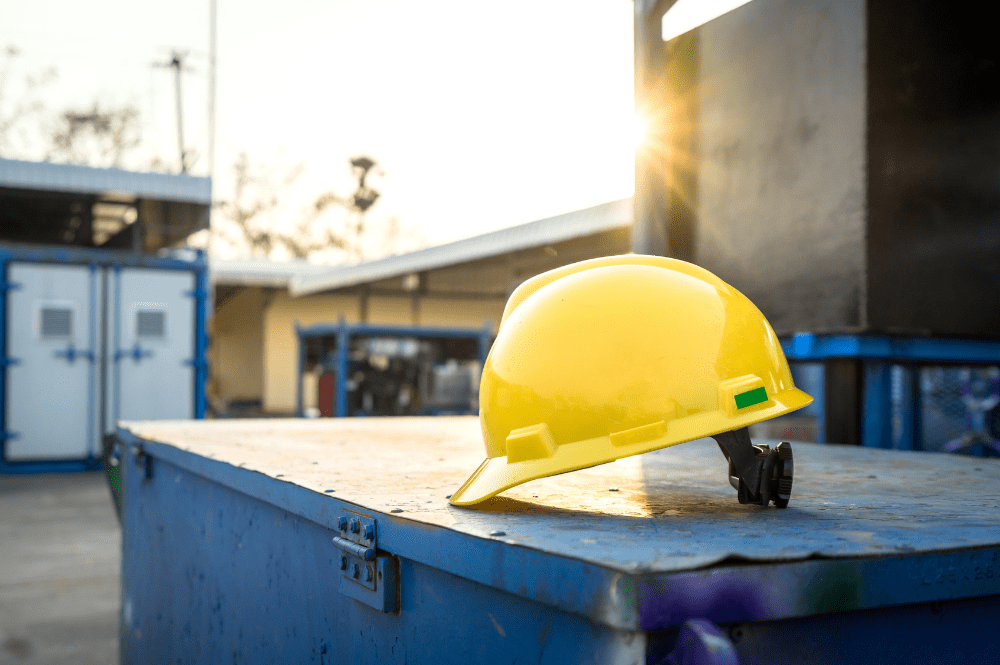Understanding OSHA Handrail Requirements: A Comprehensive Guide
Safety in the workplace is not just a priority; it’s a non-negotiable commitment. In the dynamic world of industries, where innovation and productivity thrive, safety forms the bedrock upon which success is built. At Intrepid Industries, we understand the paramount importance of ensuring the well-being of every worker, every day.
Workplace safety isn’t a mere aspiration—it’s a set of regulations and guidelines designed to protect lives and livelihoods. At the forefront of these safety standards stands the Occupational Safety and Health Administration, or OSHA. OSHA is the guardian of workplace safety, setting the rules and ensuring compliance to create secure environments for workers nationwide.
In this comprehensive blog post, we delve deep into the world of OSHA handrail requirements. We’ll explore the significance of these regulations, the specific standards they entail, and the critical role they play in safeguarding workplaces.

The Importance of Workplace Safety
Workplace safety is not just a catchphrase; it’s a fundamental necessity. The well-being of employees directly impacts the success and sustainability of any business. Here are some key reasons why workplace safety is of paramount importance:
- Human Lives: Safety measures protect the lives and health of workers, ensuring they return home safely to their families every day.
- Productivity: A safe workplace fosters greater productivity as employees can focus on their tasks without fear of accidents or injuries.
- Legal Compliance: Adhering to safety regulations is not just ethical but also a legal obligation. Non-compliance can lead to hefty fines and legal repercussions.
- Reputation: A commitment to safety enhances a company’s reputation, attracting top talent and loyal customers.
- Cost Savings: Preventing accidents and injuries reduces healthcare and compensation costs, benefiting both employers and employees.
The Significance of OSHA Regulations
OSHA, was established to ensure safe and healthy working conditions for every American worker. This federal agency sets and enforces safety and health regulations across various industries. OSHA’s significance lies in its ability to:
- Prevent Accidents: OSHA regulations are designed to identify and eliminate workplace hazards, reducing the risk of accidents.
- Protect Workers: These regulations safeguard workers from various dangers, including falls, chemical exposure, and electrical hazards.
- Standardize Safety: OSHA provides a standardized framework for safety, ensuring consistent protection for workers nationwide.
- Enforce Compliance: Through inspections and penalties, OSHA ensures that employers comply with safety standards, creating a culture of safety.
- Constant Improvement: OSHA continuously updates and improves regulations to adapt to evolving workplace challenges.
The purpose of this blog post is clear—to provide a comprehensive understanding of OSHA handrail requirements. Handrails might seem like a small detail, but they are a critical element in workplace safety. By the end of this guide, you’ll have a thorough grasp of:
- OSHA regulations related to handrails.
- The importance of handrails in fall protection.
- Specific standards for handrail design, height, and installation.
- The role of handrails in ensuring worker safety.
So, whether you’re an employer seeking to ensure compliance or an employee eager to understand your rights and protections, this guide is your roadmap to OSHA handrail requirements. Join us as we embark on this journey to create safer, more secure workplaces for all. At Intrepid Industries, safety is our foundation, and knowledge is our tool for building a safer tomorrow.
OSHA Handrail vs. Guardrail: What’s the Difference?
In the world of workplace safety, two terms often appear: handrails and guardrails. While they might sound similar, they serve distinct purposes and are crucial components of safety in various settings. Let’s delve into the key distinctions between handrails and guardrails, understand their roles in workplace safety, and discover where OSHA regulations require each type.
Key Distinctions
Height and Positioning:
- Handrails are typically positioned at a height that allows individuals to grasp them for support while walking. They are installed along staircases, ramps, and walking surfaces where there’s a risk of falling.
- Guardrails, on the other hand, are taller and are designed to prevent falls from elevated platforms, mezzanines, and raised walkways. They create a protective barrier to keep individuals from inadvertently walking off the edges.
Primary Purpose:
- The primary purpose of handrails is to provide stability and support to individuals while they ascend or descend stairs or ramps. They offer a secure grip, aiding balance and preventing slips and falls.
- Guardrails are primarily intended to act as a physical barrier to prevent falls from elevated surfaces. They serve as a protective boundary that keeps workers safe in areas where there’s a risk of falling.
Roles in Workplace Safety
Handrails play a critical role in preventing accidents on stairs, ramps, and slopes. They provide a sturdy point of contact for individuals, reducing the likelihood of losing balance and falling.
In compliance with OSHA regulations, handrails must be present in areas where there is a risk of falling. They are essential in ensuring that workers and visitors can navigate changes in elevation safely.
Guardrails are instrumental in protecting individuals from falling off elevated surfaces. They create a physical barrier that acts as a safety net, preventing accidents and injuries.
OSHA requires guardrails on platforms, mezzanines, walkways, and other elevated areas where a fall hazard exists. Compliance with these regulations is crucial to maintaining a safe work environment.
OSHA Regulations
OSHA regulations specify that handrails must be provided on stairs with four or more risers or on ramps with a vertical rise of 30 inches or more.
Handrails should be between 30 and 38 inches in height from the upper surface of the handrail to the walking surface. This range ensures a comfortable grip for users.
OSHA requires guardrails on any platform, balcony, runway, or walkway that is 4 feet or more above the lower level.
The top rail of a guardrail system should be 42 inches plus or minus 3 inches above the walking or working surface, providing a substantial protective barrier.
Understanding the differences and purposes of handrails and guardrails is crucial for maintaining a safe workplace. Whether it’s preventing slips on a staircase or protecting against falls from heights, these safety features are integral components of OSHA’s commitment to workplace safety.
The Role of Handrails in Fall Protection: OSHA’s Perspective
When it comes to workplace safety, OSHA’s perspective is clear and unwavering: handrails play a vital role in fall protection. Falls are a significant risk in various industries, and OSHA regulations are designed to mitigate this danger. Let’s delve into OSHA’s perspective on the importance of handrails and understand the consequences of non-compliance.
The Significance of Fall Protection
OSHA’s commitment to fall protection is rooted in the grim reality that fall hazards pose a substantial risk of death or serious injury in workplaces. According to OSHA’s incident data, falls are among the leading causes of occupational fatalities and injuries. Recognizing this, OSHA has established stringent guidelines and requirements to address fall hazards comprehensively.
Handrails serve as a fundamental preventive measure in fall protection. OSHA mandates their use in various settings, such as staircases, ramps, and elevated walkways, to provide stability and support to workers and visitors. Properly installed and compliant handrails significantly reduce the risk of falls and enhance overall workplace safety.
Consequences of Non-Compliance
Non-compliance with OSHA handrail requirements can have severe consequences. Workplace accidents resulting from falls can lead to not only physical harm but also financial and legal repercussions for employers. OSHA penalties for violations can be substantial, making compliance a crucial aspect of risk management.
In conclusion, OSHA’s perspective on handrails in fall protection is crystal clear: they are a critical component of workplace safety. Non-compliance can lead to dire consequences, both in terms of human well-being and financial stability. Understanding and adhering to OSHA handrail requirements is not just a legal obligation but a moral imperative for creating safer work environments.
Designing Safe and Compliant Handrail Systems
At Intrepid Industries, safety is of the utmost importance, and one crucial aspect of workplace safety is designing handrail systems that not only protect but also comply with OSHA standards. In this section, we’ll delve into the fundamental design considerations for handrail systems, break down OSHA requirements for handrail design, and provide guidance on choosing materials that meet OSHA standards while considering durability and environmental factors.
Fundamental Design Considerations
The first step in designing a handrail system is understanding its purpose and where it will be installed. Is it for a staircase, platform, or walkway? Knowing this helps determine the specific design requirements. Then, consider who will use the handrail. Ensure the design accommodates everyone, including individuals with disabilities.
While safety is paramount, aesthetics matter too. A well-designed handrail should complement the overall look of the facility. And be sure to design the handrail to be comfortable to grip and use. Factors like handrail diameter and shape are crucial.
OSHA Requirements for Handrail Design
OSHA sets specific requirements for handrail design to ensure workplace safety. Here are the key OSHA standards:
- Height: Handrails must be 30 to 38 inches above the walking surface. The top rail of a stair rail system must be 42 inches high.
- Strength: Handrails must withstand a force of at least 200 pounds applied in any direction within 2 inches of the top edge.
- Continuity: Handrails should provide continuous protection. Gaps or interruptions are not allowed, except at entrances.
Choosing OSHA-Compliant Materials
Selecting the right materials for handrail construction is crucial for compliance and durability:
- Metal: Common materials like steel and aluminum are popular choices due to their strength and durability. Ensure they are corrosion-resistant.
- Wood: Wood handrails are aesthetically pleasing but require proper maintenance to prevent decay and meet OSHA standards.
- Plastic/Composite: Some plastics and composite materials meet OSHA requirements and are low-maintenance options.
- Environmental Considerations: Factor in environmental conditions, such as exposure to chemicals or weather, when choosing materials.
In conclusion, designing safe and compliant handrail systems involves careful consideration of purpose, user needs, aesthetics, and ergonomics. Adhering to OSHA requirements for height, strength, and continuity is essential. Finally, selecting the right materials ensures your handrail system not only meets OSHA standards but also stands the test of time. At Intrepid Industries, we prioritize safety, and designing handrail systems that fulfill OSHA requirements is a key part of our commitment to workplace safety.
Innovative Safety Gate Solutions for Industry Excellence
At Intrepid Industries, our dedication to safety takes a unique twist. We pride ourselves on delivering cutting-edge safety gates that seamlessly integrate with existing OSHA handrail installations. Intrepid Industries excels in providing tailor-made safety gate solutions, specifically designed to address the distinctive needs and challenges across various industries, ensuring unparalleled compliance and safety enhancement.
Custom Safety Gates in Harmony with your OSHA Handrails
Recognizing the diverse demands of industries, we provide versatile safety gate designs that flawlessly adapt to various environments, from dynamic manufacturing floors to critical healthcare settings. And did we mention these seamlessly integrate with your OSHA handrails? Our gates are OSHA-compliant. Our safety gates utilize regulatory compliance, particularly in stringent sectors like warehouses, and within the oil industry. Our safety gates adhere to and surpass OSHA standards. In sectors where safety is important, such as construction, warehouse management, and industrial zones, we offer customizable safety gate solutions that effortlessly fuse safety with design, showcasing our commitment to comprehensive safety solutions.
Our Commitment to Safety
At Intrepid Industries, safety is our top priority. We understand that each industry has its own set of challenges and regulations. Our OSHA standard safety gates integrate with your OSHA handrail solutions perfectly. We are committed to going above and beyond to ensure compliance and safety in every environment. When it comes to handrail solutions, like safety gates, tailored to unique industry needs, Intrepid Industries is the partner you can trust.


